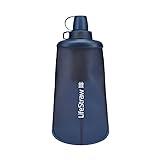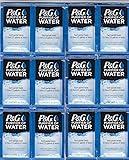Imagine this: You’re miles into your hike, surrounded by nothing but the sounds of nature. Your water supply is dwindling, and there’s a clear, bubbling stream ahead. It’s tempting to take a sip, right? I’ve been there myself, thinking the pristine wilderness water must be pure. But I learned the hard way that even the clearest stream can harbor invisible threats. That experience taught me the critical importance of water purification while hiking.
Staying hydrated is essential, especially when you’re exploring the great outdoors. But as many of us outdoor enthusiasts have learned, not all water is safe to drink straight from the source. This post is all about navigating those waters (pun intended), offering you a deep dive into various water purification methods that are both hiker-friendly and effective. Whether you’re a day-tripper or a long-distance trekker, ensuring every sip is safe can make or break your adventure.
Note: Your furry friends can also get sick from drinking contaminated water. You should bring water for them, or purify their water before they drink.
Key Takeaways
- Purifying water is a non-negotiable out in the wild to avoid waterborne illnesses.
- There’s a range of methods to choose from, each with its unique set of benefits.
- Selecting the best method depends on various factors, including the nature of your hike and personal preferences.
Understanding Water Contaminants
When you come across a serene mountain stream or a quiet lakeside, it’s tempting to take a drink without a second thought. But even the most untouched water sources can harbor contaminants that pose significant health risks. My own encounter with questionable water on a hike through the Rockies was a wake-up call to the invisible dangers lurking in natural water sources.
Types of Contaminants:
- Pathogens: These are the disease-causing organisms that most hikers worry about. They include bacteria like E. coli, viruses such as norovirus, and protozoa like Giardia lamblia. These microorganisms can lead to symptoms ranging from mild gastrointestinal discomfort to severe dehydration and illness.
- Sediments: While not as harmful as pathogens, sediments like silt, sand, and organic matter can affect water clarity and taste. They can also shield pathogens from purification efforts, making the water harder to treat.
- Chemicals: Pesticides, heavy metals, and other pollutants can find their way into even the most remote water sources due to runoff and environmental contamination. These contaminants can have long-term health effects and may not be removed by all purification methods.
Understanding these contaminants is crucial for hikers, as consuming untreated water can lead to waterborne diseases, disrupting your adventure and potentially leading to severe health issues. The U.S. Centers for Disease Control and Prevention (CDC) provides comprehensive guidelines on water treatment methods to combat these contaminants, emphasizing the importance of proper purification techniques in outdoor settings (CDC, “A Guide to Drinking Water Treatment and Sanitation for Backcountry and Travel Use”).
Purification Methods Perfect for Hikers and Backpackers
Filter Systems
Filters are like strainers for water; they catch the bad stuff while letting clean water through. There are pump filters, squeeze bottles with built-in filters, and even straw filters you can drink directly through. They’re great for getting rid of bacteria and protozoa but might not catch viruses. Plus, you’ll need to clean or replace the filters now and then.
We are big fans of LifeStraw and always carry a couple of their personal filters in each of our packs. They are affordable, last a long time, and are easy to use. Recently we came across their collapsible sqeeze bottle water filters and we are converting over to those.

LifeStraw Peak Series - Collapsible Squeeze Bottle Water Filter System – 650ml Protects against 99.999999% of bacteria (including E.coli, Salmonella), 99.999% of parasites (including Giardia and Cryptosporidium), 99.999% of microplastics, silt, sand, and cloudiness.
Boiling
Boiling water is the reliable, old-school method of water purification. If you’ve got a portable stove, you’re set. Otherwise a very small fire and a fire-safe container is all you need. Boiling for at least one minute (or three at higher altitudes) can kill most germs, making the water safe to drink. It’s simple but requires time and fuel.
Note: You would be surprised what you can boil water in. Plastic bottles, Ziploc bags, and even Styrofoam cups will all work if you are careful, go slow, and don’t let the flames hit above the water level.
Chemical Purification
Using chemicals like iodine or chlorine tablets is like having a magic pill that purifies water. You drop a tablet into your water, wait a bit (usually 30 minutes), and voila! The water’s safer to drink. Many people, like us, don’t love the taste but it’s a lot better than being thirsty. Still, they are light and affordable so it’s worth throwing some of these in your first-aid kit just in case.

P&G; Purifier of Water Portable Water Purifier Packets. Emergency Water Filter Purification Powder Packs for Camping, Hiking, Backpacking, Hunting, and Traveling. (12 Packets)
UV Light Purification
UV light purifiers are like the high-tech gadgets of water purification. Shine a UV light in your water for a few minutes, and it zaps away the harmful organisms. They’re lightweight and quick but need batteries or solar power. These are still a bit pricy so we haven’t tried them before but from reading reviews they seem like good products. One possible downside is that they aren’t filters so the water will still contain all the muck and silt. If your high in the mountains this probably isn’t a problem but it’s something to keep in mind.

SteriPen Adventurer Opti UV Personal Water Purifier for Camping, Backpacking, Emergency Preparedness and Travel. Safe and effective without altering taste, pH, or other properties of water; chemical-free
Natural Methods
In a pinch, you can use nature’s own materials like sand, charcoal, and cloth to filter water. There are two methods that we think are worth knowing about and will work in most areas. These methods can improve water clarity and taste but might not remove all harmful organisms, so it’s best used with another purification method if possible.
Dig, Wait, Drink: The Infamous Coyote Well: How to get water in a survival Situation - Coalcracker Bushcraft How to Build a Charcoal Water Filter From Scratch - The Survival SummitChoosing the Right Method for Your Hike
Deciding on the best water purification method for your adventure isn’t just about what’s easiest or fastest. It’s about matching your method to the terrain, the length of your hike, and your own personal needs. Here’s how to make that choice a bit easier:
Consider the Duration and Location of Your Hike
- Day Trips vs. Extended Treks: For shorter hikes, a lightweight and easy-to-use method like a UV light purifier or a filter bottle might be ideal. On longer treks, especially in areas where water sources might be heavily contaminated, a more robust solution such as a pump filter combined with chemical treatment could be necessary.
- Wilderness Areas vs. Established Trails: In remote areas where water sources are likely to be more contaminated, a combination of methods (e.g., pre-filtering with a cloth to remove sediments, followed by chemical treatment) can offer extra protection. On established trails with access to clearer water sources, a simple filter or UV purifier might suffice.
Assess Water Availability and Quality
- Abundance of Water Sources: In areas with plentiful water sources, carrying a more substantial pump filter might not be a burden, as you can refill often. In arid regions, you might prefer chemical tablets or a UV purifier to save weight, knowing water sources are scarce.
- Quality of Water Sources: Clear, flowing water is generally safer than stagnant, cloudy water. If you expect to encounter the latter, opt for methods that can handle heavy sediment, like pump filters with pre-filters or sediment settling followed by UV treatment.
Personal Preference and Capacity
- Ease of Use: If you prefer simplicity, chemical treatments or UV purifiers offer a straightforward approach without the need for pumping or squeezing. However, if you’re okay with a bit more effort for a higher volume of purified water, a pump filter might be your go-to.
- Taste Preferences: Some hikers are sensitive to the taste alteration caused by chemical treatments. In such cases, filtering methods or UV purification, which don’t change the water’s taste significantly, might be more appealing.
Redundancy for Safety
It’s wise to carry a backup method, such as chemical tablets, even if you prefer another primary method. Unexpected failures, like a broken filter or dead batteries, can leave you vulnerable.
Tailoring Your Choice
Ultimately, the right water purification method is one that suits your specific hiking scenario and personal preferences. By considering these factors, you can ensure you stay hydrated and healthy, no matter where your trails lead you.
Conclusion
Access to clean water is a must on any hike, and with the right purification method, you can quench your thirst worry-free. Whether you prefer the simplicity of boiling, the convenience of chemical tablets, the tech-savvy UV light, or the practicality of filters, staying hydrated and healthy on the trail is within your reach. So, gear up, choose your purification method, and set off on your next adventure with confidence!
References
-
U.S. Centers for Disease Control and Prevention (CDC). “A Guide to Drinking Water Treatment and Sanitation for Backcountry and Travel Use.” CDC, https://www.cdc.gov/healthywater/drinking/travel/backcountry_water_treatment.html. Accessed 28 Feb 2024.
-
World Health Organization (WHO). “Guidelines for Drinking-Water Quality, 4th Edition.” WHO, https://www.who.int/publications/i/item/9789241549950. Accessed 28 Feb 2024.
